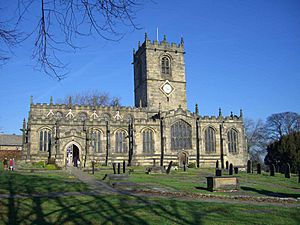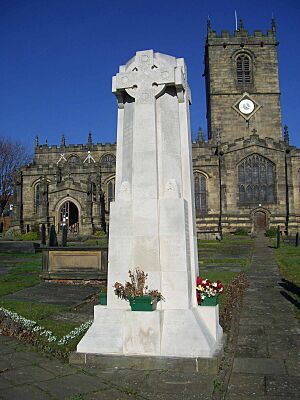Church of St Mary, Ecclesfield facts for kids
The Church of St Mary, Ecclesfield is an important old church located on Church Street in the village of Ecclesfield, which is part of Sheffield, South Yorkshire, England. It's about 4 miles north of the city centre. This church is a very special building, listed as Grade I, which means it's one of the most important historical buildings in the whole country. It was once the main church for a huge area called Hallamshire. In the 1600s, people called it the "Minster of the Moors" because it was in a very rural area back then.
Contents
History of the Church
How Old is St Mary's?
We don't know the exact year a church was first built here. The name Ecclesfield might mean "Church in the Field" in an old language called Old English. The area is mentioned in the Domesday Book, a famous survey from 1086, but the church itself isn't. Historians think that the Anglo-Saxons might have built a church on this spot between 625 and 650 AD.
Early Buildings and Owners
After the Norman conquest of England in 1066, the land around Ecclesfield was given to a person named William de Lovetot in the early 1100s. He built the first big church on this site. Some people say it was built in 1111, but there's no old document to prove that date.
Later, the church was given to monks from Fontenelle Abbey in France. This made it an "alien priory," which was a small group of French monks living in England. In 1386, King Richard II of England closed these foreign priories. He gave the church to the Carthusian Monks of Coventry. They looked after it until the Dissolution of the Monasteries in the late 1530s, when King Henry VIII closed many monasteries. After that, the church was given to the Lords of Hallamshire.
A Very Large Parish
At that time, the church's parish (the area it served) was huge, covering 82 square miles! This made it one of the biggest parishes in England. Because it was so large, Ecclesfield had four churchwardens (people who help manage the church) instead of the usual two. This tradition is still kept today.
Building the Current Church
The church you see today started being built in 1478 and was finished around 1500. It was built in the Perpendicular style, which is a type of English Gothic architecture. However, some parts of the church, like parts of the nave (the main body of the church) and the pillars that hold up the roof and tower, are from the older 12th-century building.
Changes Over Time
In the 1640s, during a time of strong Puritan beliefs, many of the church's decorations and all its stained glass windows were broken. This happened after a law in 1643 said that all pictures of angels or saints in churches should be removed or destroyed. Some of the broken glass was later put back together and placed in windows in the north aisle and vestry. In the 1700s and 1800s, more changes were made inside the church, especially to the nave and chancel, by vicars named William Ryder and Alfred Gatty.
In 1878, a football club that represented Ecclesfield Church joined the Sheffield Football Association.
St Mary's Today
Modern Touches and Accessibility
Today, the church is still very active and has some modern features. It has a kitchen, a lavatory (toilet), and modern heating and lighting. In 2019, it was recognized as a Major Parish Church. In 2021, work was finished to create a new entrance at the West End. This new entrance has level access and electric doors, making it easier for everyone to get into the church, whether they are able-bodied or have mobility challenges.
Inside the Church
The church is built from local stone. Inside, you'll find an octagonal (eight-sided) font, which is used for baptisms. The pulpit, where sermons are given, was installed in 1876. It has four carved panels showing scenes from the life of St Paul. The lectern, where readings are given, was also installed at the same time.
Since the Second World War, both the chancel (the area around the altar) and the nave have had new roofs. The church tower holds ten bells that can be rung together, and two of these bells are from the 1600s! Music in the church is provided by a pipe organ.
War Memorial and Ancient Crosses
In the churchyard, there is a war memorial made of light-coloured limestone. It was designed by R. B. Brook-Greaves. This memorial has the names of 54 local people who died in the First World War, 36 who died in the Second World War, and one man who died in the Falklands War. This memorial is also a Grade II listed building.
The church is home to a rare carved Anglo-Saxon cross shaft. It dates back to the early 11th century AD and is about five feet tall. It was found buried outside the west door in 1892 and has since been put back together inside the church. In 2020, pieces of a second cross were found in the same spot. There's also a sundial in the churchyard, which sits on a base that might be very ancient.
Famous Burials
Several important people are buried in the churchyard:
- Joseph Hunter was a famous historian and record keeper. He wrote an important local history book called Hallamshire in 1819.
- Alexander John Scott was the chaplain (a type of priest) to Horatio Nelson, a famous British admiral. Scott was with Nelson when he died at the Battle of Trafalgar.
- Alexander John Scott's daughter, Margaret Gatty, was a writer and botanist (someone who studies plants).
- Parkin Jeffcock was an English mining engineer. He died trying to rescue miners during the Oaks mining disaster.
The current vicar of St Mary's is Revd. Dr. Tim Gill. He started his role on July 28, 2016.



